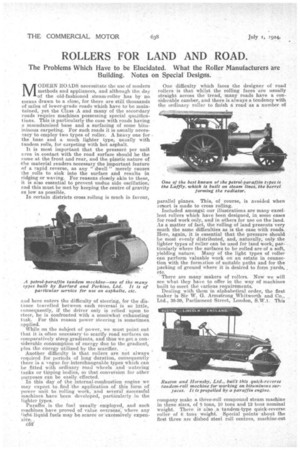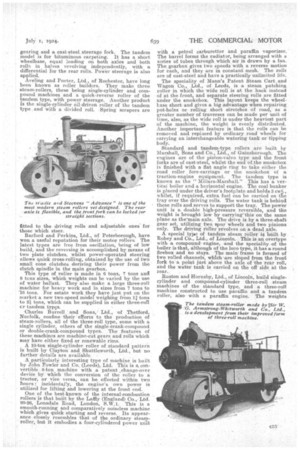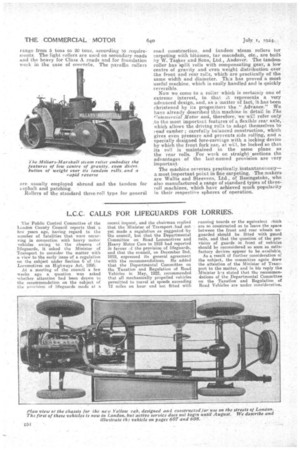ROLLERS FOR LAND AND ROAD.
Page 40

Page 41

Page 42

If you've noticed an error in this article please click here to report it so we can fix it.
The Problems Which Have to be Elucidated. What the Roller Manufacturers are Building. Notes on Special Designs.
°DERN BONDS necessitate the use of modern methods and appliances, and although the day of the old-fashioned steam-roller has by no means drawn to a close, for there are still thousands of miles of lower-grade roads which have to be maintained, yet the Class A and many of the secondary roads require machines possessing special qualifications. This is particularly the case With roads having a macadamized base and a surfacing of some bituminous carpeting. For such roads it is usually neceasary to employ two types of roller. A heavy one for the base and a much lighter type, us-aally with tandem rolls, for carpeting with hot asphalt.
It is most important that the pressure per unit area in contact with the road surface should be the Fame at the front and rear, and the plastic nature of -the material renders necessary the important feature of a rapid reverse, as any " 'dwell " merely causes the rolls to sink into the surface and results in ridging or waving. For reasons closely akin to these, it is also essential to prevent undue side oscillation, and this must be met by keeping the centre of gravity as low as possible.
In certain districts cross rolling is much in favour, and here enters the difficulty of steering, for the distance travelled between each reversal is so little, consequently, if the driver only is relied upon to steer, he is confronted with a aombwhat exhausting task. For this reason power steering is sometimes applied.
While on the subject of power, we must point out that it is often necessary-to scarify road surfaces on comparatively steep gradients, and thus we get. a con-. siderable consumption of energy due to the gradient, plus the energy utilized by the scarifier. .
Another difficulty is that rollers are not always required for periods of long duration, consequently there is a vogue for interchangeable types which can be fitted with ordinary road wheels and watering tanks or tipping bodies, so that conversion for other purposes can be easily effected.
In this day of the internal-combustion engine we may expect to find the application of this form of power unit to rolling work, and several successful machines lia,ve been developed, particularly in the lighter types.
Paraffin is the fuel usually employed, and such machines have proved of value overaeas-, where any tight liquid fuels may be scarce or-excessively expensrqe..
One difficulty which faces the designer of road rollers • is that whilst the rolling faces are usually straight across the tread, many roads have a considerable camber, and there is always a tendency with the ordinary roller to finish a road as a number of parallel planes. This, of course, is avoided when :resort is made to cross rolling.
Included amongst our illustrations are many excellent rollers which have been designed, in some eases for road work only, and in others for use on the land. As a matter of fact, the rolling of land presents very much the same difficulties as is the case with roads. Here, again, it is essential that the pressure should. be most evenly distributed, and, naturally, only the lighter types of roller can be used for land work, particularly where the surfaces to be rolled are-of a soft, yielding nature. Many of the light types of roller can perform valuable work on an estate in connection with the formation of suitable paths and for the packing of ground where it is desired to form yards, etc.
There are many makers of rollers. Now we will see what they have to offer in the way of machines built to meet the various requirements.
Dealing with them in alphabetical order, the first maker is Sir W. G. Armstrong Whitworth and Co., Ltd., 38-39, Parliament Street, London, S.W.l. This
company make a three-roll compound steam machine in three sizes, of 8 tons, 10 tons and 12 tons nominal weight There is also a tandem-type quick-reverse roller of 6 tons weight. Special points about the first three are dished steel roll centres, machine-cut gearing and a cast-steel steerage fork. The tandem model is for bituminous carpeting. It has a short wheelbase, equal loading on both axles and• both rolls in halves revolving independently, with a differential for the rear rolls. Power steerage is also applied.
Aveling and Porter, Ltd., of Rochester, have long been known as roller builders. They make three steam-rollers, these being single-cylinder and compound machines and a quick-reverse roller of the tandem type, with power steerage. Another product is the single-cylinder oil-driven roller of the tandem type and with a divided roll. Spring scrapers are fitted to the driving rolls and adjustable ones for those which steer.
Barford and Perkins, Ltd., of Peterborough, have won a useful reputation for their motor rollers. The latest types are free from oscillation, being of low build, and the reversing is accomplished by means of two plate clutches, whilst power-operated steering allows quick cross-rolling, obtained by the use of two small cone clutches deriving their power from the clutch spindle in the main gearbox. This type of roller is made in 6 tons, 7 tons anti 8 tons sizes, which weights can be varied by the use of water ballast. They also make a large three-roll machine for heavy work and in sizes from 7 tons to 16 tons. For estate work they have jnst put on the market a new two-speed model weighing from 11 tons to 21 tons, which can be supplied in either three-roll cr tandem types. Charles Burrell and Sons, Ltd., of Thetford, Norfolk, confine their efforts to the production of steam-rollers, all of the three-roll type, some with a single cylinder, others of the single-crank-compound or double-crank-compound types. The features of these machines are machine-cut gears and rolls which may have either fixed or renewable rims.
A 10-ton single-cylinder roller of standard pattern built by Clayton and Shuttleworth, Ltd., but no further details are available.
A particularly interesting type of machine is built by John Fowler and Co. (Leeds), Ltd. This is a. convertible 8-ton machine with a patent _change-over device by which the conversion of the roller to a tractor, or vice versa, can be effected within two hours ; incidentally, the engine's own power is utilized for lifting and lowering at the front end. One of the best-known of the internal-combustion rollers is that built by the Laffiy (England) Co.,Ltd. 20-26, Lonsdale Road, London, S.W.1. This is a smooth-running and comparatively noiseless machine which gives quick starting and reverse. Its appearance closely resembles that of the ordinary steamroller, but it embodies a four-cylindered power unit with a petrol carburetter and paraffin vaporizer. The barrel forms the radiator, being arranged with a series of tubes through which air is drawn by a fan. The gearbox gives two speeds with a reverse motion for each and they are in constant mesh. The rolls are of cast-steel and have a practically unlimited life_ The speciality of Mann's Patent Steam Cart and Wagon Co., Ltd., of Leeds, is a steam patching roller in which the wide roll is at the back instead of at the front, and separate steering rolls are fitted under the smokebox. This layout keeps the wheelbase short and gives a big advantage when repairing pot-holes or rolling short stretches of road, as a greater number of traverses can be made per unit of time, also, as the wide roll is under the heaviest part of the machine' the weight is evenly distributed. Another important feature is that the rolls can be removed and replaced by ordinary road wheeTs for carrying an interchangeable watering tank or tipping body. Standard and tandem-type rollers are built by Marshall, -Sons and Co., Ltd., of Gainsboroagh. The engines are of the piston-valve type and the front forks are of cast-steel, whilst the end of_the smokebox is finished with a fiat angle ring to take either the road roller fore-carriage or the smokebox of a. traction-engine equipment. The tandem type is known as the " Millars-Marshall." This has a vertieat boiler and a horizontal engine. The coal hunker Is placed under the driver's footplate and holds 3 cwt., whilst, if required, extra fuel can be carried on the tray over the driving rolls. The water tank is behiid. these rolls and serves to support the tray. The power unit is a double high-pressure reversible, and the weight is brought low by carrying this on the same .plane as the-main axle. The drive is by a three-shaft gear set, .utilizing. two spur wheels and two pinions only. The driving roller revolves on a dead axle. A special type of tandem steam roller• is built by Robey and Co., Ltd., of Lincoln. This is an overtype with a compound, engine, and the speciality of the boiler is that, although of the loco type, it has a round firebox and no stays. The main frame is formed of two rolled channels, which 'Are sloped from the front fork to a point just above the axle of the rear roll, and the water tank is carried on the off side at the rear.
Ruston and Hornsby, Ltd. of Lincoln, build singlecylinder and compound-cylinder three-roll steam machines of the standard type, and a three-roll machine constructed to use paraffin and a tandem roller, also with a paraffin engine. The weights range from 5 tons to 20 tons, according to requirenients. The light rollers are used on secondary roads and the heavy for Class A roads and for foundation woik in the case of conerete.. The paraffin rollers
are usually employed abroad and the tandem for esphalt and patching. Rollers of the standard three-roll type for general
road construction, and tandem steam rollers tor carpeting with bitumen, tar macadam, etc., are built by W. Tasker and Sons, Ltd., Andover. The tandem roller has split rolls with compensating gear, a low centre of gravity and even weight distribution over the front and rear rolls, which are practically of the same width and diameter. Tirs has proved a most useful machine, which is easily handled and is quickly reversible.
Now we come to a roller which is certainiy one of extreme interest, in that ,it represents a very advanced design, and, as a matter of fact, it has been christened by its progenitors the Advance," We hav,e already described this machine in detail in The Oornmercial Motor and, therefore, we will refer only :to the most important features of a flexible rear axle, which allows the driving rolis to adapt themselves to road camber ; carefully balanced construction, which gives even pressure and prevents side rolling, and a specially designed fore-carriage with a locking device by which the front fork can at wilt, be locked so that its roll is maintained in the same plane as the rear rolls. For work on straight sections the advantages of the last-named provision are very important.
The machine reverses practically instantaneo uslya most important point in fine carpeting. The Makers are Wallis and Steevens, Ltd., of Basingstoke, who also manufactured a range of standard types of threeroll machines, which have achieved much popularity in their respective spheres of operation.














































